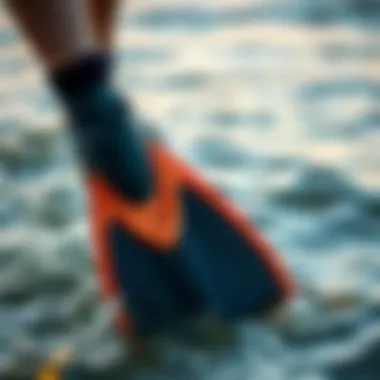The Most Comfortable Swim Fins: Your Ultimate Guide


Intro
When it comes to swimming, comfort is king—especially for those who spend hours splashing around in the water. This is where swim fins step into the limelight, giving swimmers not just an edge in propulsion but also enhancing their overall experience. Depending on the activities, whether you are a casual pool-goer or an ocean lover chasing waves, the right pair of fins can make a world of difference. In this guide, we'll dive into everything you need to know about swim fins, focusing on the factors that contribute to their comfort, usability, and performance.
Fins aren’t just about looking cool while gliding through the water; their design influences your movement, stamina, and even your technique. Models vary widely, from those suited for competitive swimming to fins made for snorkeling or free diving. Each type comes with unique features that cater to different needs. Let's peel back the layers on this aquatic gear and explore how to choose the best fins that suit your style and skill level.
Gear and Equipment
Choosing the right swim fins is like picking the right shoes for a hasty trek—comfort, fit, and functionality are pivotal.
Swim Fins Breakdown
Different styles of fins have been engineered to address various swimming modalities:
- Short Fins: Ideal for sprinters and training, allowing swimmers to maintain proper body position and kicking technique.
- Long Fins: These are built for maximum propulsion, perfect for free divers who need to cover distances without tiring quickly.
- Diving Fins: Often made from a stiffer material, these fins allow deep divers to move efficiently.
Each of these types is carefully constructed from various materials such as silicone, rubber, and thermoplastic, contributing to comfort and performance. Some might feel as soft as butter against your skin while others may have a firmer feel that provides more thrust. Opting for the right material can significantly enhance your overall swimming experience.
Considerations for Comfort
When selecting swim fins, a snug fit, without being too tight, is crucial. The last thing you want is blisters on your heels or toes after a long swim. Here are a few elements to keep in mind:
- Foot Pocket Design: A well-designed foot pocket should cradle your feet comfortably against the fin.
- Sizing: Always refer to the size chart and, if necessary, try them on if you're purchasing in store. Different brands may have slightly varied sizing standards.
- Adjustability: Some fins come with adjustable straps, allowing you to achieve a customized fit.
"The right fins can change the way you swim—experience that glide firsthand to appreciate it fully."
Additional Accessories
To complement your swim fins, there are a few essential accessories worth considering:
- Fin Socks: These offer an extra layer of comfort and protection against chafing. Particularly useful for longer sessions.
- Fins Bag: Keeping your fins safe and organized can save you from unnecessary wear.
- Storage Solutions: Drying racks or mesh bags can ensure your fins maintain their shape and longevity.
Choosing the right swim fins involves careful thought around both equipment design and personal comfort. As we continue this comprehensive guide, we’ll also touch on feedback from users, tips for maintenance, and guide you toward making a wise purchasing decision.
Prologue to Swim Fins
Swim fins are essential tools for anyone looking to enhance their aquatic experience, whether it’s for recreational purposes or serious training. They help swimmers propel themselves more efficiently through the water, minimizing fatigue while maximizing speed. The right pair of fins can make the difference between a seamless glide through water and a frustrating struggle against resistance.
When discussing swim fins, it’s not just about choosing a pair that looks good or fits in your bag; comfort plays a significant role in performance. An uncomfortable fin can lead to distractions or even injuries, the last thing any swimmer wants while trying to master their strokes. Therefore, understanding how swim fins function and the elements that contribute to comfort is critical, especially for surfers, outdoor enthusiasts, and travel bloggers who frequently find themselves in and out of the water.
In this article, we will delve into the intricate world of swim fins. From understanding their design to considering the materials used and how these factors contribute to comfort, our aim is to provide comprehensive insights that will help both beginners and advanced swimmers make informed decisions.
"The only way to improve your swim fin experience is to truly know what to look for in each pair."
By the end of this guide, you will have not only the knowledge but also a clearer picture of which fins are truly worth your investment. Let's first unpack the basics of swim fins—what makes them tick and how they play a vital role in enhancing performance.
Types of Swim Fins
When it comes to swim fins, choosing the right type is crucial for enhancing comfort and performance in the water. Different designs serve unique purposes, making it essential for swimmers to understand the specifics surrounding each kind. Ultimately, the goal is to amplify your swimming experience, be it for leisure or sport. Understanding the various types of fins will empower you to make an informed decision, allowing you to maximize your time in the water.
Open-Heel Fins
Open-heel fins are designed with an adjustable strap that allows for a custom fit, making them a popular choice among divers and swimmers alike. What sets them apart is their versatility; they can be worn with or without neoprene socks. This feature is particularly advantageous for swimmers who often find themselves navigating varying water temperatures.
The flexibility of the open-heel design also means they can be used by multiple users, changing the fit according to their feet. This saves both money and space, making them ideal for buddy groups or families that share gear. In addition to comfort, swimmers often notice improved propulsion due to the larger surface area of the blade, which works well for both speed and endurance. However, remember to check the fit carefully. If they’re too loose, they may cause blisters or cramps over time.
Full-Foot Fins
Full-foot fins, as the name indicates, offer a snug fit that covers the entire foot without any adjustable straps. They tend to be lightweight and are easier to slip on, making them suitable for those who prefer a "grab-and-go" approach to swim gear. These fins work exceptionally well in warmer waters where comfort is key.
That snug fit often translates into more efficient energy transfer from the legs to the fins, a major advantage for swimmers focusing on technique. However, keep in mind that these fins may become uncomfortable during extended periods in cooler water, leading to chilled toes. It’s wise to choose a size that balances comfort and snugness, while still allowing blood flow and flexibility.
Short Fins
Short fins are often favored by swimmers looking to improve their technique, as they help develop proper kick motion without placing excessive strain on the legs. Their compact size makes them ideal for pool use and close-quarter training where space is limited. They're lighter too, making them easier to pack for travel.
Incorporating short fins into training routines can yield significant benefits. These fins force swimmers to concentrate on form and body position, honing their skills without the risk of overexertion. They are perfect for young swimmers or those who are just beginning their underwater journey.
Long Fins
On the flip side, long fins are your go-to if speed is your primary concern. They offer increased surface area, which allows for greater propulsion while swimming. Long fins can be a game changer for those who compete or swim long distances regularly. However, it’s crucial to note that they can accelerate muscle fatigue because of the additional effort required to maneuver.
These fins are often heavier, making them less practical for casual swimming. Dive deeper into the water with long fins and feel the surge of power they provide. Weight often doesn’t equate to discomfort; many swimmers find that, with practice, they can manage the added heft quite well.
Choosing the right type of swim fin affects not just comfort but overall performance. Whether you lean towards open-heel, full-foot, short, or long fins, each has its unique benefits and considerations. Taking the time to understand and evaluate these options will play a significant role in enhancing your swimming experience.


Materials Used in Swim Fins
Selecting the right swim fins involves more than just considering their shape and size; the materials used in their construction play a crucial role in ensuring comfort, performance, and durability. Each type of fin material introduces unique characteristics that can enhance or hinder a swimmer's experience, making it essential to understand these elements before making a purchase. Knowing the differences in materials can help you avoid uncomfortable experiences and accelerate your learning curve in the water.
Rubber Fins
Rubber fins have been favored for quite some time among swimmers because of their natural stretch and flexibility. One of the key benefits of rubber is its ability to conform closely to the shape of the foot, which leads to an extremely snug fit while still being easy to slip on and off.
- Durability: Rubber fins generally hold up well against wear. They can withstand the salty nature of ocean waters and the harshness of chlorinated pools.
- Floating: Unlike many rigid materials, rubber can offer buoyancy, helping swimmers maintain a more comfortable position in the water.
- Cushioning: The soft nature of this material offers a cushioned feel against the skin, minimizing the risk of blisters, especially during longer swim sessions.
However, rubber fins can be on the heavier side, which might impact speed or agility for some swimmers. Additionally, they can absorb water, causing them to feel more sluggish than their lighter counterparts.
Silicone Fins
Enter the silicone fin—an advanced material that has gained traction over the years. Silicone fins are known for their smooth texture and exceptional softness, which attract swimmers who value comfort above all.
- Comfort: The softness of silicone truly shines, as it molds to the foot's shape while providing a snug grip. This feature makes long swims more bearable than traditional materials.
- Lightweight: These fins are usually lighter than rubber counterparts, allowing for increased speed and less fatigue during activity.
- Minimal Water Absorption: Silicone fins tend to absorb less water, keeping them light and easy to maneuver.
On the flip side, silicone fins can be less durable over time, particularly if subjected to rough conditions. They might not be the best option for those engaging in rigorous swim training or in harsh environments due to the potential for damage from sharp objects or rough surfaces.
Plastic and Composite Fins
Plastic and composite fins represent the modern take on swim fin technology. These materials are engineered for performance, offering a different experience compared to traditional rubber and silicone.
- Strength: Plastic fins are often stiffer, which translates to power and efficiency during swimming. This stiffness can greatly aid in generating speed, making them suitable for athletes focused on performance.
- Customization: Composite fins can be engineered to achieve optimal flex and weight distribution, allowing for more personalized experiences. This means they can be designed for various swimming styles, from casual to competitive swimming.
- Cost-Effective: Typically, plastic fins tend to be more budget-friendly, making them accessible for beginners or casual users.
However, one downside is that their rigid construction can lead to discomfort over time, particularly if not adequately fitted. Swimmers may experience issues like cramps or blisters as the stiff fins may not allow for as much natural movement.
In summary, the choice of material significantly influences both comfort and performance in swim fins. As a surfer, outdoor enthusiast, or travel blogger looking for the best swimming experience, understanding these materials will guide you towards making the right choice.
For further information, check out resources such as Wikipedia for in-depth technical information on swim fins, or community discussions on Reddit for real-world experiences and recommendations.
Key Features That Enhance Comfort
Choosing the right swim fins goes beyond just picking a color or style; comfort plays a pivotal role. Comfortable swim fins not only enhance enjoyment but also improve your swimming efficiency. Within the realm of swim fins, certain features are instrumental in achieving this level of comfort. Understanding these features helps swimmers select the best fins that cater to their individual needs.
Foot Pocket Design
The foot pocket design is perhaps the most critical factor in determining how comfortable a fin will feel on your feet. A proper foot pocket allows for just the right amount of snugness without being restrictive. The distribution of pressure across the foot can make or break your experience.
Several brands incorporate soft materials and contours that fit the natural shape of the foot. For example, some fins have a rounded toe box, which prevents pinching while allowing for better blood circulation during extended swims.
“A snug but comfortable fit is key; it helps reduce the chances of blisters and soreness, allowing you to focus on your technique rather than your feet.”
Considerations for foot pocket design include:
- Sizing options: Fins that cater to a wider range of foot sizes can accommodate various swimmers.
- Lining material: A soft lining can greatly reduce chafing, providing comfort for long sessions in the water.
- Adjustability: Some designs offer adjustable straps, which allow swimmers to modify the fit based on comfort needs.
Blade Flexibility
Blade flexibility is another significant player in the comfort game. The stiffness of the blade affects the propulsion and the effort required to swim efficiently. If the blade is too stiff, it can cause unnecessary fatigue in the feet and legs. Conversely, a blade that is too flexible may not provide enough thrust, making swimming feel like you're dragging along.
Swimmers should consider their skill level and the type of swimming they intend to do. For instance, beginner swimmers may benefit from a more flexible blade to ease strain on their legs, while advanced swimmers might prefer stiffer blades for added speed.
Key aspects of blade flexibility include:
- Material composition: Fins made from advanced composites can provide an optimal blend of flexibility and strength.
- Design features: Certain fins are engineered with channels that enhance water flow and reduce drag, complementing the blade's natural flex.
Weight and Balance
Lastly, the weight and balance of swim fins significantly influence comfort. Lighter fins reduce the effort required to kick, allowing for longer durations in the water without fatigue. A well-balanced fin will also help in maintaining a natural swimming posture, facilitating smoother strokes.
The weight of the fin impacts how it feels in the water, while balance affects maneuverability. Swimmers should seek fins that don’t feel cumbersome and maintain a steady flow during use.
When considering weight and balance, think about:
- Design balance: How the weight is distributed across the fin—this impacts stability during kicks.
- Overall fin weight: Lightweight materials can enhance performance without sacrificing durability.
Selecting the Right Size
Choosing the right size is crucial when it comes to swim fins. An ill-fitting pair can ruin your experience in the water, making it uncomfortable and difficult to achieve the desired performance. Proper size ensures that the fins fit securely without being too tight or loose. If you are in the market for swim fins, think of selecting the right size as a pivotal part of your decision-making process that can make or break your swimming efficiency.
With swim fins, sizing isn't always straightforward. Brands may have different sizing charts, and what works for one person might not work for another. It is essential to know that the right size will not only affect comfort but also impact your overall swimming technique and speed. A snug fit can prevent slipping off while you are making powerful strokes. On the other hand, a fin that's too tight can cause friction and ultimately lead to blisters.
Size Charts and Fit Guidelines
When searching for swim fins, you’ll usually come across a size chart specific to the brand you’re interested in. These charts can take the guesswork out of finding the perfect fit. They often provide ranges based on shoe sizes, but you should also consider the following:


- Foot Width: Some brands cater to wider or narrower feet. If you know your foot tends to be on the broader side, look for fins that offer that flexibility.
- Sizing Variability: Don't be surprised if two brands list different sizes for similar foot dimensions. It might require trying out a few pairs.
- Temperature Considerations: Swimmers who use fins in colder waters may want a tighter fit to prevent cold water from entering the fins.
It’s advisable to read the fit guidelines thoroughly. Always double-check your measurements against the size charts provided by the manufacturer.
Importance of Proper Fit
A proper fit isn't a luxury; it is a necessity for effective swimming with fins. When you have fins that suit your foot well, you may notice that you can maintain your speed without expending extra energy on compensating for a poor fit. An evident benefit includes:
- Improved Stroke Technique: Properly fitting fins can enhance your kick, as they align more uniformly with your feet! You swim with greater efficiency and reduce drag, which is a boon for both amateur and competitive swimmers alike.
- Comfort and Reduced Fatigue: Comfort can’t be understated. If your fins fit like a glove, you can swim longer without feeling fatigued. In contrast, a wrong size may lead you to cut your sessions short.
- Safety Benefits: Loose fins can lead to accidents or even create a situation where you lose a fin mid-swim, which could cause distress. This is especially relevant in competitive settings or open water situations.
In summary, prioritizing the right size when selecting swim fins will lead to a more enjoyable and efficient swim, allowing you to focus on improving your skills and enjoying the sport itself.
Remember: Don’t rush into selecting a size. Investing time in this decision pays dividends in comfort and performance!
Performance Considerations
When it comes to swim fins, performance is as crucial as comfort. The right pair of fins can amplify a swimmer's experience in the water, whether they're paddling through a calm bay or tearing through ocean waves. The factors that influence performance largely revolve around two key elements—speed and endurance. Let's delve deeper into these aspects to understand their significance and how they intertwine with the design of swim fins.
Impact on Speed and Endurance
Speed and endurance are the cornerstones of swimming performance, and swim fins play a pivotal role in enhancing both. Fins are designed to provide extra propulsion by increasing the surface area of the foot, allowing for powerful kicks that propel the swimmer forward. This added thrust can significantly reduce the energy expenditure required to maintain a certain speed, thereby enhancing endurance.
A few aspects to consider regarding speed and endurance include:
- Blade Length: Longer fins often create greater propulsion, enabling quicker speeds. However, they may demand more energy to kick, which can affect longevity during longer swims.
- Blade Stiffness: A stiffer blade translates into more direct, forceful propulsion. Conversely, a flexible blade tends to be gentler on the muscles, allowing for sustained effort over longer distances.
- Kick Technique: The ability to optimize one’s kick while using fins can lead to improved speed. The right fins encourage streamlined movements, promoting efficiency and reducing drag in the water.
Remember, though, that while fins can boost speeds, over-reliance on them can lead to unbalanced muscle development, which may hinder performance without them. Striking the right balance is vital for both short sprints and distance swims.
Influence on Technique
The interplay between swim fins and technique cannot be overstated. Proper technique is essential not just for competitive swimming but also for casual swimmers seeking to improve their skills. Swim fins can guide users toward more effective kicking mechanics, promoting habits that lead to better overall technique.
Here are some elements to help you appreciate how fins influence technique:
- Body Position: Fins help maintain a more streamlined posture in the water. They enable swimmers to keep their legs elevated, reducing drag and allowing for smoother strokes.
- Kicking Rhythm: Using fins can facilitate a consistent kicking rhythm, which is important for synchronization with arm strokes. This is especially crucial for those learning the essentials of freestyle or butterfly techniques.
- Feedback Mechanism: When swimmers use fins, they can feel the difference in propulsion and resistance. This heightened awareness can promote corrective actions in their movements, leading to improved overall swimming technique.
To sum up, while swim fins enhance speed and endurance, they also serve as tools for refining technique. The heart of an effective swimming practice should center around balancing these aspects to cultivate a well-rounded skill set.
"Choosing the right fins can transform your swimming experience, elevating your skills while ensuring comfort and reducing fatigue."
For optimal results, it’s recommended that swimmers experiment with various fin types and sizes to find the perfect match that complements their unique style and goals. Taking the time to understand how your fins impact performance will pay dividends in your swimming journey.
User Feedback and Reviews
User feedback and reviews hold significant weight in the world of swim fins, acting as a compass for potential buyers navigating through a sea of options. The insights provided by other swimmers can illuminate paths for both newcomers and seasoned pros alike. The reflections of users contain practical knowledge that may not be found in manufacturers’ descriptions or specifications.
Customer reviews can reveal the true comfort levels of different models. For instance, a fin advertised as comfortable may not feel the same after hours of swimming. Users often highlight key points like the snugness of the foot pocket, blade stiffness, and any discomfort during prolonged use. Moreover, these insights can shed light on the durability of a fin, which is particularly crucial for those who swim regularly or in varied water conditions.
Benefits of User Feedback
- Real-World Experiences: Unlike marketing jargon, user testimonials provide authentic, unfiltered experiences. Reading about how a particular fin performs in various conditions can help potential buyers gauge their own needs better.
- Common Issues: Sometimes, a specific model might seem perfect at first glance but has underlying issues only revealed through user experiences. Buyers can avoid unwelcome surprises by paying attention to what others have said about a fin’s performance under pressure.
- Comparative Analysis: By reading through various reviews, shoppers can compare several brands and models side by side, identifying strengths and weaknesses without having to try them all first-hand.
- Community Insights: Platforms like Reddit or specialized forums allow fans of swimming to engage in discussions about their personal experiences, recommendations, and tricks they’ve learned over time. Such community-driven insights can be invaluable.
Things to Consider When Evaluating Feedback
- Volume and Consistency: A product with numerous positive reviews is often more trustworthy. Look for patterns in reviews rather than isolated praises or complaints.
- Reviewer Credibility: Spotting enthusiastic first-time users against seasoned swimmers can provide context. A beginner might rave about features that an experienced swimmer would find inadequate.
- Diverse Conditions: Pay attention to reviews that address different types of swimming environments since comfort can vary greatly from a calm pool to turbulent ocean waters.
As all these insights demonstrate, user feedback can serve as a reliable guide to choosing the right swim fins. Listening to those who have come before ensures you don’t miss out on the most comfortable and fitting options that suit your swimming style.
Analyzing Customer Experiences
Analyzing customer experiences reveals a panorama of preferences, ranging from casual swimmers exploring a leisurely day at the beach to intensive training sessions by competitive athletes. Such firsthand accounts can surface specific features that make a difference in comfort levels.
For example, consider a feedback snippet from a user discussing their experience with the Cressi Lago Full Foot Fins. They might mention how the soft rubber foot pocket comfortably cradled their foot without pinching or causing blisters. Others could talk about how the blade flexibility assisted in executing their strokes with ease without compromising power. The beauty lies in the diversity of these experiences, showcasing firsthand info that's often more reliable than quantified data found in product catalogs.
Customer feedback forms the digital tapestry that tells us not just what swim fins do, but how they feel. As diverse swimmers add their voices, future buyers gain a clearer picture through shared trials and tribulations that inform future purchasing decisions.
Commonly Discussed Points
- Fit and Comfort: Many users emphasize the importance of a well-fitted fin. Most feedback will include comments about the foot pocket, hinting that what feels snug and secure for one may feel tight for another.
- Durability: Users frequently touch on how well their fins have held up over time, often sharing tips on care practices based on their experiences with wear and tear.
- Performance: The characteristics of swim fins, such as thrust and maneuverability, are also hot topics in reviews. Some may speak on how certain styles enhanced their speed during swim meets.
Expert Recommendations
Expert recommendations can serve as a roadmap, pointing swimmers towards the best options based on extensive knowledge and evaluation. Experts in aquatic sports often conduct tests, compare products, and delve into the technicalities of swim fin design��—bringing credibility that ordinary consumer feedback might not possess.
When an expert recommends fins like the Mares Plana Avanti Superchannel, it’s usually grounded in various factors such as the fin’s material, blade design, or foot pocket comfort. Experts might discuss how the channeling effect of the blades helps with propulsion and minimizes fatigue, a detail that would matter significantly to experienced endurance swimmers.


Relying on Expert Insights
- Performance Testing: Often, industry experts report on performance under specific conditions. This is crucial, as merely owning a pair of swim fins doesn't guarantee a certain performance level; how they act in diverse aquatic environments is key.
- Safety Considerations: Specialists may offer insights into choosing fins that balance performance with safety—all the while ensuring that swimmers can feel confident in their equipment.
- Trends: Experts are typically abreast of trends and innovations in swim fins—be it sustainable practices, new materials emerging in the market, or advanced design features revolving around human physiology.
Having data from experts can save time for consumers who might be overwhelmed by the variety of choices in swim fins, leading them toward well-regarded models with proven track records. Such recommendations can breathe clarity into the often murky waters of equipment purchasing—ultimately aiding swimmers in making educated decisions that benefit their aquatic endeavors.
"A good pair of swim fins is more than an accessory; it’s an extension of a swimmer's technique and style."
Maintenance Tips for Longevity
Taking proper care of your swim fins not only enhances their lifespan but also ensures optimal performance with every kick. A pair of comfortable and effective swim fins can significantly impact your aquatic experience, making it essential to maintain them with a bit of effort. Proper maintenance minimizes wear and tear, which can occur over time due to exposure to harsh elements, water conditions, and simply regular usage. This section conveys practical advice to help you keep your fins in the best shape possible, ensuring that they remain a reliable companion for all your underwater adventures.
Cleaning and Care
Cleaning your swim fins is crucial to preventing the build-up of algae, sand, and salt, which can degrade the material over time. Here’s how to keep them spick and span:
- Rinse Immediately: After each use, always rinse your fins with fresh water. This simple step can greatly extend their life. Make sure to open the foot pockets and wash any debris that might have collected inside.
- Gentle Scrub: If you notice any stubborn stains or dirt, use a soft brush. Avoid harsh scrubbing tools as they can scratch and damage the surface.
- Dry Properly: Lay your fins flat in a shaded area to dry. The sunlight can warp the rubber or silicone and lead to cracks, so steer clear of direct sunlight.
- Storage: When storing your fins, it’s wise to keep them in a cool, dry place. Consider using a mesh bag to prevent moisture buildup, as damp environments can foster mold or mildew.
Adhering to these practices ensures that your swim fins maintain their shape and functionality. A well-cared-for pair of swim fins not only performs better but also feels more comfortable on your feet, allowing you to enjoy longer swims without discomfort.
Store and Transport
Proper storage and transportation of swim fins play a significant role in their durability and arrangement. Here’s how to make sure they travel well:
- Use a Dedicated Bag: Consider investing in a fin-specific bag. This not only keeps them protected but also helps to avoid any unwanted scratches from other gear in your travel kit.
- Avoid Compression: Do not stack heavy items on top of your fins when storing them. This can distort their shape and make them less effective when it comes time to use them.
- Air Exposure: While you want them stored safely, don’t forget to leave your fins exposed to the air occasionally. This minimizes any potential odor buildup and keeps the material fresh.
- Check Before Traveling: Before heading out for a swim or diving expedition, make a habit of checking your fins for any damage. Ensuring they're in good condition before a trip saves time and stress later.
In summary, proper maintenance, cleaning, and appropriate storage will ensure that your swim fins remain a crucial asset in your water sporting experiences. Taking just a little time out of your day to care for them can make a world of difference in your next swim.
Comparison of Popular Brands
When it comes to swim fins, understanding the distinctions among various brands is pivotal for an optimal swimming experience. The market offers many options, each designed with unique features, performance attributes, and comfort levels. Through a detailed comparison of popular brands, swimmers can make more informed decisions about which fins best align with their specific needs, preferences, and goals.
Considerations when comparing brands include material quality, design innovation, performance capabilities, and customer support. You might want to think about how the foot pocket accommodates various foot shapes, or how the blade's flexibility affects propulsion in water. Additionally, engaging with fellow enthusiasts on platforms like reddit.com can offer real-world insights that formal marketing often omits.
Furthermore, some brands focus on creating products that prioritize sustainability while ensuring high-performance levels. Such considerations can significantly impact both your swimming efficiency and the environmental footprint of your gear.
Brand A Overview
Brand A has long been hailed as a leader in the swim fin market, renowned for its cutting-edge technology and comfort-driven designs. One of its most notable products is the AquaFusion Fin, which features a unique blend of silicone that molds to the foot, providing a snug fit without compromising flexibility. Their fins are designed to cater to all levels, being suitable for novices to competitive swimmers.
Customer feedback consistently highlights the immediate comfort of these fins. Unlike other brands, the soft foot pocket reduces chafing and increases water flow efficiency, making it easier to achieve higher speeds with less effort. This design decision places Brand A at the forefront of user-centric innovations in swim equipment.
Brand B Overview
Brand B stands out with its commitment to sustainability, using eco-friendly materials in its fin production. Their flagship product, the EcoSwim Fin, uses recycled plastics and biodegradable substances to minimize environmental impact without sacrificing performance.
In terms of comfort, users often commend Brand B for its adaptive foot pocket, which allows for personalized adjustment. This adaptability ensures that the fins stay secure during intense use, which is crucial for swimmers focusing on endurance. Reviews suggest that the flexibility of the blades helps maintain a natural kick motion, essential for technique-driven swimmers.
Brand Overview
Brand C is often associated with elite aquatic sports, focusing on high-performance swim fins that cater to competitive swimmers. Their product line features the Velocity Fin, designed for maximal thrust and speed. The fins are slightly stiffer than those of other brands, which can provide advanced swimmers with the power necessary for explosive starts.
However, while performance is a top priority, feedback from users indicates that comfort can be a double-edged sword. Some swimmers find the firmer foot pocket less forgiving over extended periods. Brand C emphasizes the importance of proper sizing more than others, encouraging users to consult their detailed sizing chart to avoid discomfort. Overall, their motivation for performance-driven design clearly resonates within the competitive swimming community.
"In the world of swimming, the right fins can be a game changer. Finding the perfect pair requires a keen eye and an understanding of what each brand offers."
Choosing the right brand ultimately depends on individual preferences, whether one prioritizes comfort, sustainability, or performance. Understanding what each brand brings to the table can make all the difference as you embark on your swimming journey.
Trends and Innovations in Swim Fins
In the ever-evolving world of aquatic sports, trends and innovations in swim fins play a crucial role in enhancing not only performance but also overall comfort for the swimmer. The swim fin market has witnessed several advancements that address the needs of both recreational and competitive swimmers alike. By understanding these trends, one can make more informed choices when selecting swim fins that reflect individual preferences and swimming goals.
New Technologies
One of the most significant advancements in swim fin technology is the integration of advanced materials. For example, many brands now utilize hybrid materials that blend silicone and rubber to create fins that are both pliable and durable. This combination allows for better foot pocket fit while maintaining a solid balance between thrust and flexibility.
The design of fins has also evolved to include hydrodynamic features. Streamlined shapes reduce drag in the water, allowing swimmers to move with less resistance, improving speed and efficiency. A notable example of this is the curved blade fins which maximize propulsion with minimal effort, making them ideal for distance training or those refining their technique.
Moreover, adjustable straps and custom fit options have gained popularity. Some manufacturers are now offering fins that allow swimmers to tweak the tightness or angle of the foot pocket, adapting to individual needs. This innovation not only enhances comfort but also prevents blisters and chafing, which are common complaints among swimmers.
"New technologies in swim fins are transforming the way athletes approach their training and performance. From custom fits to optimized designs, the latest innovations empower swimmers to achieve their personal best."
Sustainability in Swim Fin Production
As environmental concerns continue to rise, sustainability in swim fin production is increasingly at the forefront of many brands. Swimmers today are more conscious about the environmental impact of their gear. Hence, many companies have started using eco-friendly materials for producing swim fins. This includes recycled plastics and biodegradable composites that significantly reduce the carbon footprint associated with manufacturing.
Additionally, some brands are pioneering the practice of local sourcing and production, minimizing transportation emissions. This approach not only supports local economies but also aligns with a growing demand for products with lower ecological impact.
It is crucial to be aware of how purchasing decisions can influence the industry. Opting for brands that prioritize sustainability can lead to a significant shift toward more environmentally responsible manufacturing practices in the aquatic sports sector.
Incorporating sustainable practices also often leads to innovative design solutions. Some swim fins now feature modular designs that allow for easy repairs or upgrades, prolonging the life cycle of the product. This contrasts with the traditional notion of disposable gear, encouraging a culture of longevity and mindfulness in equipment management.
Overall, trends and innovations in swim fins are not just about performance. They encompass the larger picture of user comfort, technological advancement, and eco-conscious choices that resonate with today's conscientious swimmer. By staying updated on these trends, one can select fins that not only fit well but also align with personal values and goals.







